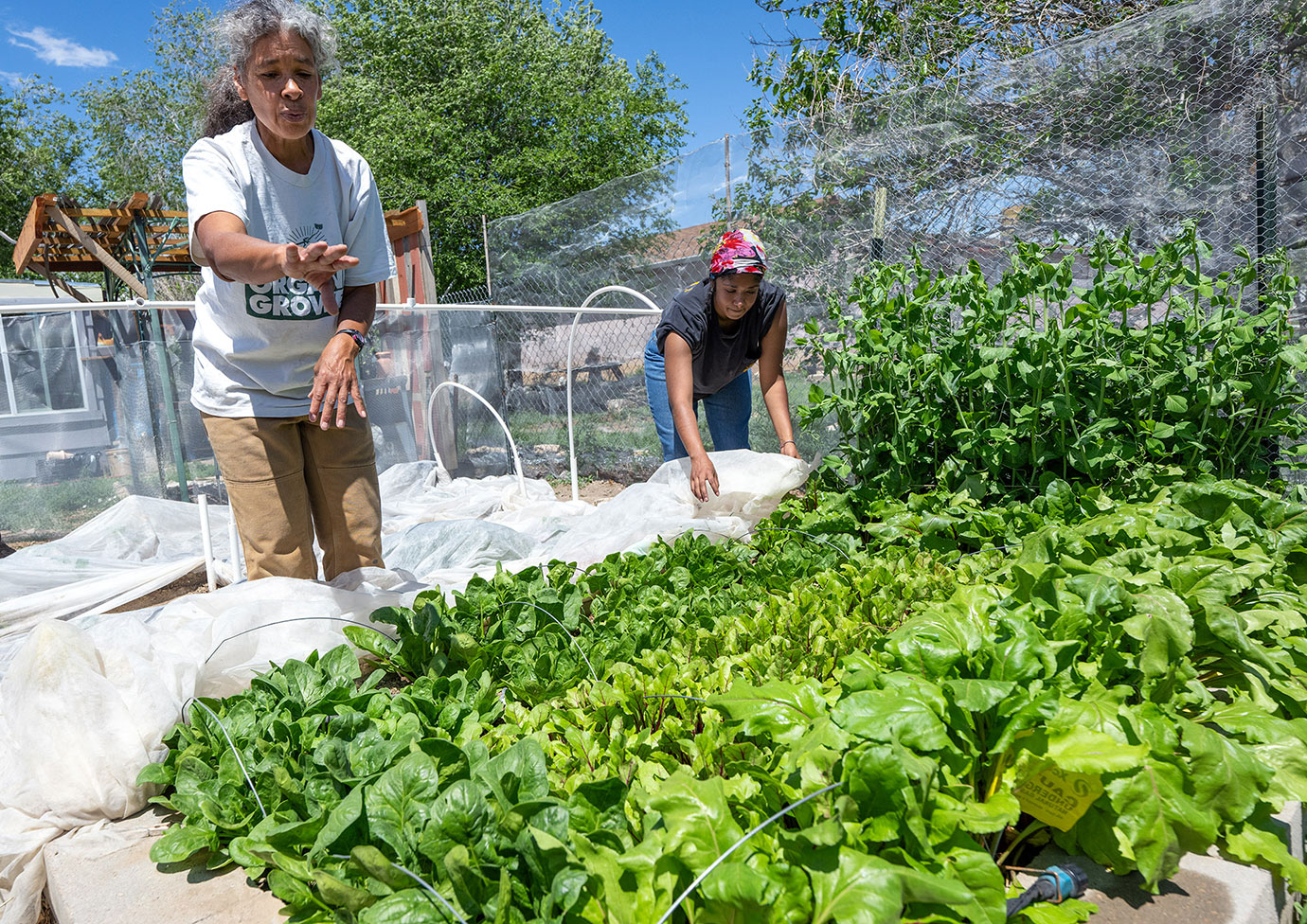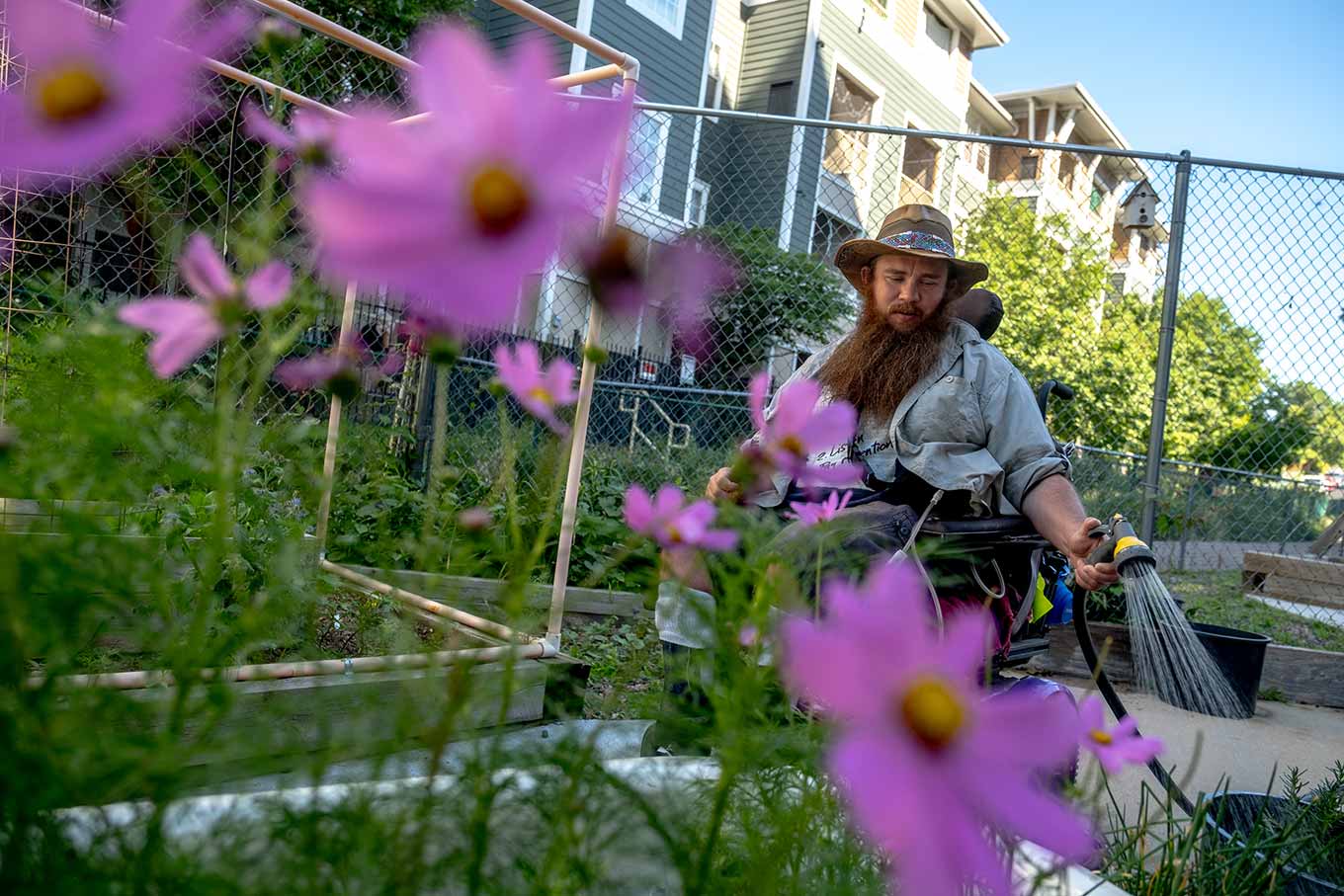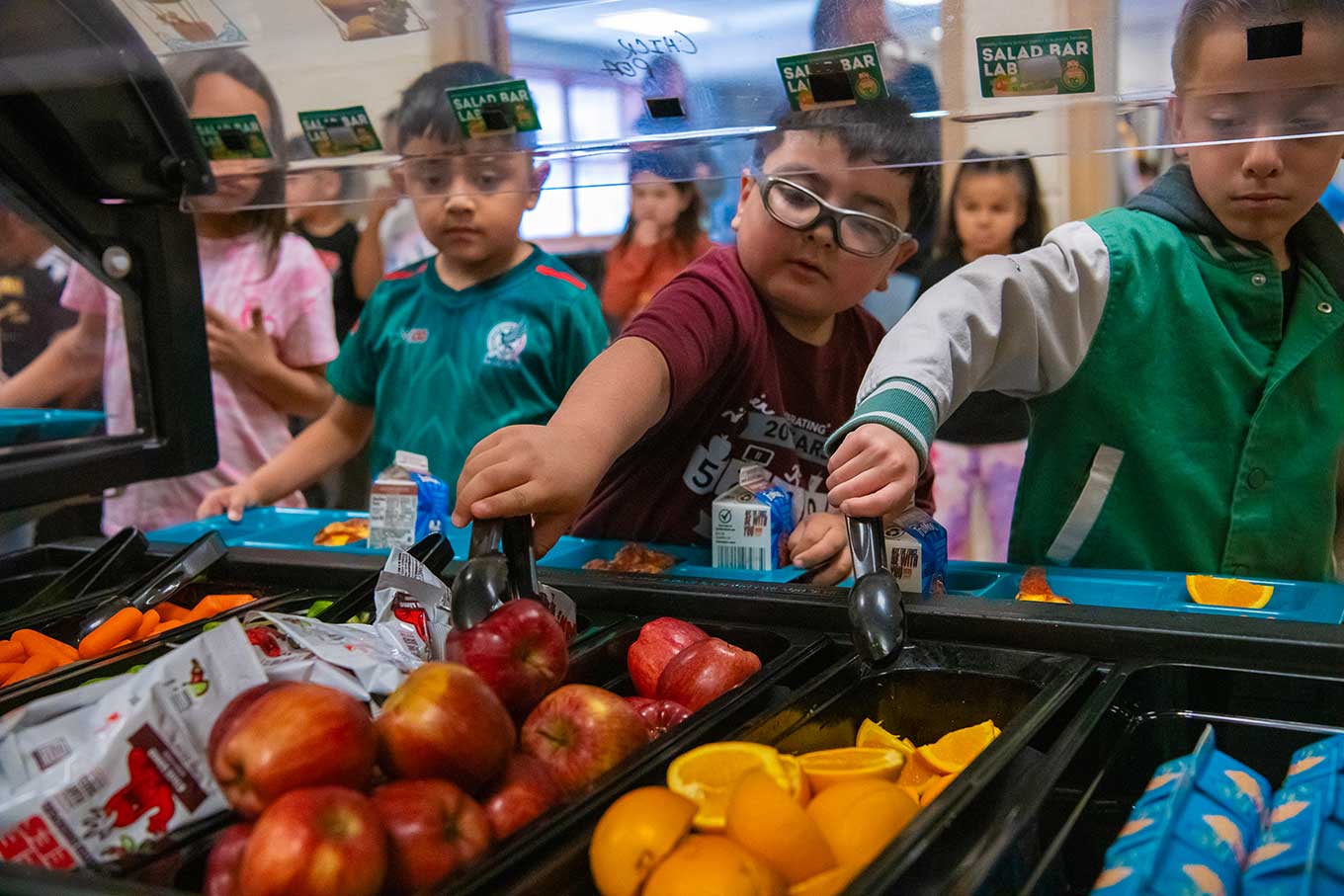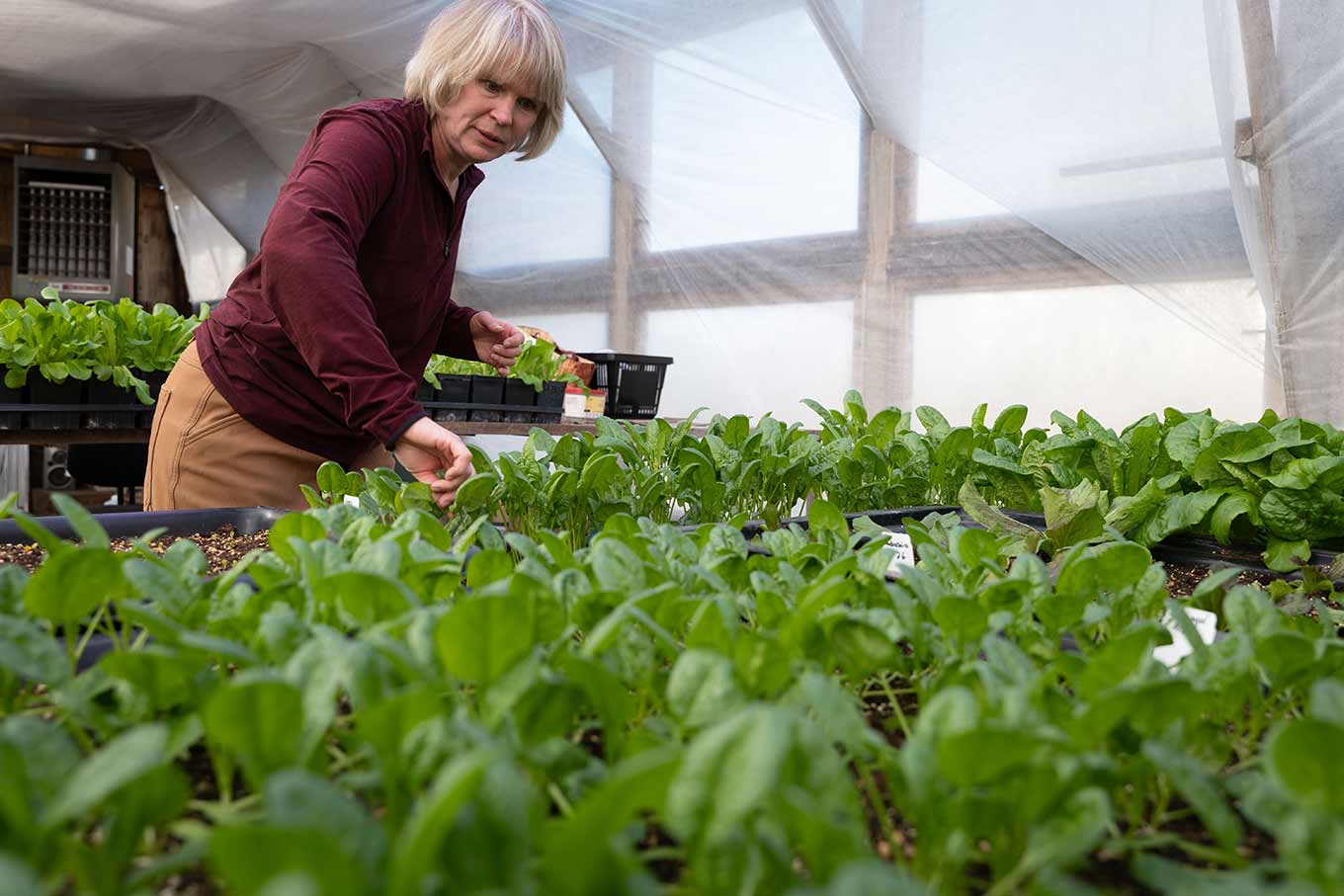Urban farmer Perdita Butler was ready to harvest her bok choy and fresh, chewy kohlrabi outside her 1940s stucco home in Pueblo. It was early spring, and the nymph grasshoppers were already munching her crops, forcing her to cover her beds with protective gauze nets. She carefully peeled back the nets to reveal blue potatoes, golden beets, dinosaur kale and other vegetables erupting from the soil.
“What I love about farming is there’s always something new to learn,” Butler said, looking at the snap peas taking off on one side of the garden.
Later this summer, she’ll sell these vegetables and others she’s growing at a new farmers market on Pueblo’s East Side neighborhood—a community without a grocery store since the Safeway in the area closed seven years ago. Butler hopes to build community and improve nutrition in the neighborhood by selling fresh, affordable produce grown five miles away on her microfarm Quarter Acre and a Mule.
Federal, state and local programs that incentivize buying produce at farmers markets, including those in Pueblo, make them affordable to some low-income families and older adults in Colorado. In addition to increasing participants’ access to fresh fruit and vegetables, these programs support small farmers like Butler and boost local economies, especially during the summer and fall harvest cycles.
Three programs specifically help low-income older adults and women and their children in Colorado: Colorado Women, Infants, and Children (WIC) Farmers’ Market Nutrition Program, Boulder County WIC Farmers Market Program, and the Colorado Nutrition Incentive Program.
“It’s a win-win. You’re feeding people. You’re supporting farmers,” said Daysi Sweaney, director of healthy food incentives at Nourish, a nonprofit that helps implement and run some of these programs.
Consumers and growers have participated in farmers market programs in Colorado over the past five years, but barriers such as funding cuts and limited time, transportation and money remain challenges.
Farmers Market Programs
According to the nonprofit Feeding America, Pueblo is among 10 counties with the highest rates of food insecurity in the state. Still, efforts to help families afford local produce are growing in the area. At the other Pueblo Farmers Market location, in downtown Mineral Palace Park, redemption of incentives for fruit and vegetables by low-income families increased significantly from $9,000 in 2020 when it began accepting them to $25,000 last year.
Growth of the federal Supplemental Nutrition Assistance Program (SNAP) and Double Up Food Bucks—a grant-funded program available in some states like Colorado that gives SNAP participants double the amount to spend on fruit and vegetables—and the WIC Farmers’ Market Nutrition Program has contributed to the increased use, said Marci Cochran, market director for the Pueblo Farmers Market.
“The WIC Farmers’ Market Nutrition Program is explosive in Pueblo,” Cochran said of the program.
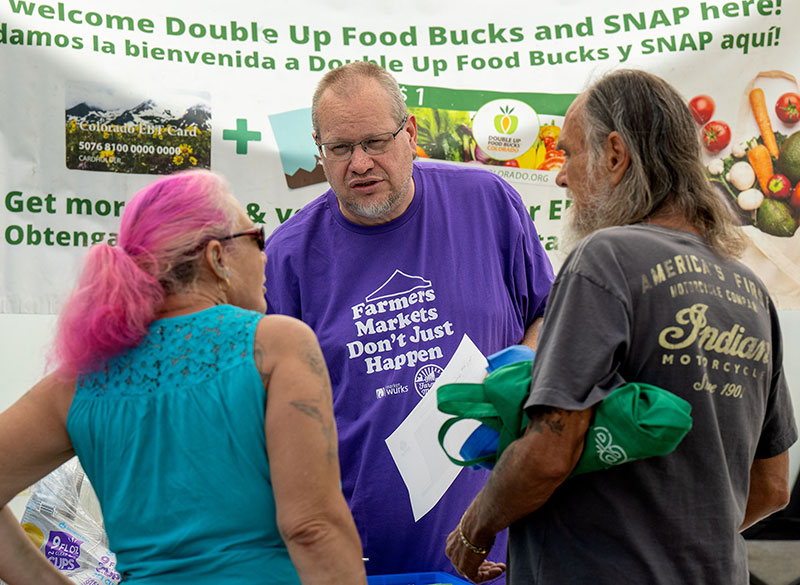
William Eaton of the Pueblo Farmers Market explains the partnership with federal food programs to help low-income patrons buy quality produce. The Eastside Farmers Market events will take place on Saturdays through Oct. 12 at the former Spann Elementary School. Photo by Mike Sweeney / Special to The Colorado Trust
Funded by the U.S. Department of Agriculture, the Colorado Department of Public Health and Environment program gives $30 annually in coupons for each participating family member to spend at 22 participating farmers markets (down from 24 last year) statewide before Oct. 31. For example, a pregnant or new mom and her two children over six months of age would have $90 to spend during the season, an increase of roughly 8% from their annual WIC budget of approximately $1,092 for fruit and vegetables.
Angelika Sunie, 25, of Pueblo, who has two children ages 1 and 4, has used the WIC Farmers’ Market Nutrition Program for the past two seasons.
“It really helped stretch my benefits,” said Sunie, who also uses SNAP and Double Up Food Bucks.
Sunie bought green beans, Pueblo chiles and Palisade peaches at the farmers market. She made a peach crisp and a simple syrup out of peaches for tea.
She said it helped her bring healthier foods into her home during the summer. Sunie added that she would have spent twice the amount allocated if it had been available.
When she was pregnant with her son in 2022, Sunie said eating more nutritious foods from the farmers market helped her pregnancy. However, she does not qualify for the program now that she has started a new job at UCHealth.
Sweaney said WIC families’ spending at farmers markets is highest along the Front Range corridor stretching from Pueblo to Greeley, but the redemption rate statewide is relatively low.
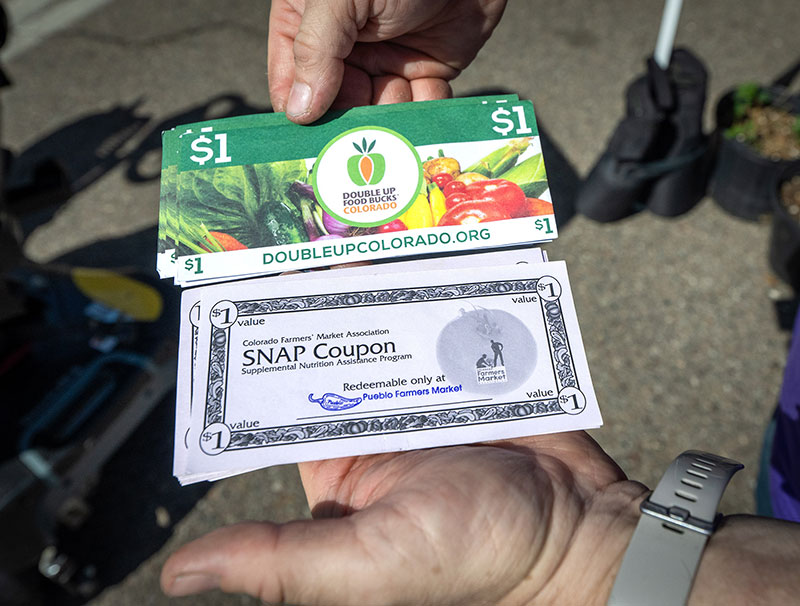
William Eaton holds SNAP coupons and DoubleUp Food Bucks at a Pueblo Farmers Market event on May 18, 2024. Organizers have partnered with food programs to enable low-income patrons to buy goods. Photo by Mike Sweeney / Special to The Colorado Trust
According to CDPHE data, the use of the coupons has risen from 17% in 2021 to 23% in 2023. (The program was first piloted in 2020.) Emily Bash, a nutrition and physical activity specialist at CDPHE, said she hopes to increase the rate this year by mailing coupons earlier, using text reminders and offering handouts in multiple languages.
Bash and her colleagues also received a $350,000 USDA grant to move from paper coupons to a digital system. It’s easy to lose paper coupons or forget to bring them to a farmers market, Bash said, and buyers can’t get change if their purchase is less than the coupon amount. She said these digital systems are already successful in Nebraska, New Mexico and Washington.
Nourish’s budget to help run programs like these was drastically cut this year by federal WIC funding. Sweaney said there is always fear that money for extra initiatives like these will dry up.
Sweaney and Bash noted that transportation is also a barrier for program participants. According to 2023 CDPHE data, families who live farther away from a farmers market were less likely to use coupons than those who lived in the same zip code as a farmers market.
Cochran said that proximity is why the Pueblo Eastside Farmers Market could be a game changer for residents. “We have a Dollar General and a Dollar Tree and a convenience store, but there is no real food access.”
Local Solutions
Meanwhile, county governments like Boulder have created their own solutions. Making local produce affordable and accessible is the focus of a 7-year-old program that provides a punch card worth $80 for Boulder County WIC families and $160 for City of Boulder WIC families per month to spend at farmers markets, helping to supplement the federal money they receive.
Zhuldyz Tokbulatova, 32, a stay-at-home mom, bikes with her 3-year-old son in a bike trailer to the Boulder Farmers Market on Wednesdays and Saturdays to participate in the program. On one Saturday in June, she bought fava beans, tomatoes and cucumbers. Cherries were in season, along with her son’s favorite fruit, aprium, a mix between an apricot and plum.
“He’s a picky eater. He doesn’t eat everything. But he likes to come with me to the farmers market, and he likes to shop there,” Tokbulatova said. “He talks to the vendors and helps pick out vegetables.” His first solid food as an infant was squash from the market.
Tokbulatova, who has participated in the program for four years, said she would not be able to afford to shop at the farmers market without the program. The family’s income is low, and they are careful about their spending.
“It’s very important for me to be able to provide local, fresh produce,” she said. Tokbulatova did not grow up eating many vegetables in her native Kazakhstan, but the program allows her to make more salads or add extra vegetables to staples like beef stew. “It fulfills me as a mother.”
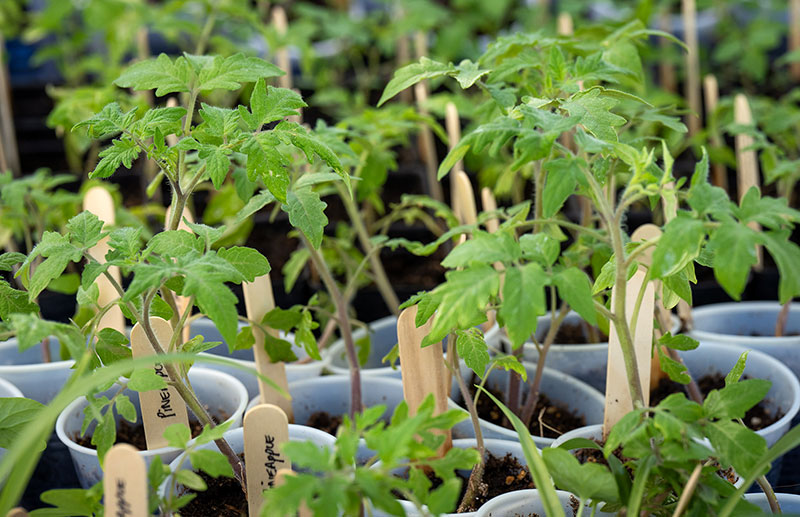
Pineapple tomato starts from Sweet Valley Farms in Manzanola are displayed at a recent Pueblo Farmers Market plant sale. Photo by Mike Sweeney / Special to The Colorado Trust
More than 1,000 Boulder County families bought $296,000 worth of farmers market produce from April to November last year—more than double the $116,000 spent by WIC families statewide. It is entirely locally funded by the county’s sustainability tax, the City of Boulder’s Health Equity Fund and the City of Longmont’s Human Services Fund. To overcome transportation challenges, volunteers deliver farmers market produce to families’ homes.
In Garfield County, the local WIC agency used extra funds at the end of the 2023 season to purchase produce from Early Morning Orchard in Palisade, then gave it away for free to 130 families who came in for height and weight measurements as part of WIC wellness checks in Rifle and Glenwood Springs. The hope is for this to become an annual tradition in Garfield County, said Christine Dolan, nutrition programs manager for Garfield County Public Health.
Community-Supported Agriculture
The Colorado Nutrition Incentive Program connects some of these families directly to produce from local growers—no farmers market required. Community-supported agriculture (CSA) shares—which run through the summer months—provide weekly boxes of freshly harvested fruit and vegetables to Colorado WIC families and older adults.
For the past three years, Highwater Farm in Silt has provided CSA shares to WIC families in Garfield County. Families visit the 3-acre farm weekly to select harvested produce, with an option to walk into the fields and pick things like cherry tomatoes, snap peas, herbs and flowers. Alternatively, Highwater Farm delivers shares to pickup spots in Glenwood Springs and Carbondale, where families receive a curated share of produce.
Highwater Farm Manager Rebecca Gourlay said CSAs are a relatively new concept for some families along Colorado’s Western Slope. She includes familiar vegetables like lettuce, onions, garlic, beans and peppers in the boxes.
But it’s also an opportunity to introduce families to new vegetables like arugula or mustard greens. These are explained in a weekly newsletter in English and Spanish that includes new recipes. The farm has a part-time bilingual outreach coordinator who talks to families during pickups.
“She helps us connect with our Latino community in a more meaningful way,” Gourlay said.
Without subsidies, it’s difficult for low-income families to afford CSAs, Gourley said, because a person has to pay upfront in the winter for produce provided throughout the summer and fall seasons.
Despite successful partnerships like those at Highwater, overall funding for the CSA program in Colorado dipped to $320,000 in 2024, down from $1.2 million in 2023. Since the program’s inception in 2019, it has relied on state, federal and philanthropic funding. This year, its grant did not allow Nourish to pay farmers 100% upfront for the summer’s produce, and some small farmers, already operating on thin margins, could no longer afford to participate, Sweaney said. Fewer than 30 farmers signed up this year, compared with 115 last year.
Becca Jablonski, co-director of the Food Systems Institute at Colorado State University, worries about farmers relying on subsidies and venues that may not exist in the future. While more data points are needed to fully understand how nutrition incentive programs benefit farmers’ overall bottom lines compared to alternatives, Jablonski said the programs could make rural farmers markets more attractive to farmers if they significantly increase the overall amount of money spent. (Cochran, with the Pueblo Farmers Market, said that nutrition incentive programs kept the market afloat during the COVID-19 pandemic.)
Jablonski’s research has shown that incentive programs benefit local economies in states like California and Colorado.
“For every $1 invested in a healthy food incentive program, we can expect to see up to $3 in economic activity generated,” she and her co-authors wrote. In Colorado, conservative estimates for scaling these programs statewide would create 92 jobs, $4.3 million in labor income, and an economic contribution of $19.8 million, based on data from 2018 and 2019.
At the state level, there is some stability for these programs next year. In June, the Colorado legislature created the Healthy Food Incentives Program—a bill allocating $500,0000 for fiscal year 2024-25 to support Nourish’s work, including CSA produce boxes for low-income families.
But Sweaney said the appropriation is insufficient to meet the box demand. Nourish plans to work with the state legislature’s Joint Budget Committee to secure more state funds and advocate for more federal funding for local food systems and food access in the upcoming U.S. Farm Bill.
Building Community Through Food
On a Saturday morning in May, farmer Brett Mills of Sweet Valley Farm drove 45 minutes to sell plant starters for heirloom tomatoes as part of an early-season pop-up event at the Pueblo Farmers Market. Whatever he didn’t sell, he planned to donate to community gardens.
“We want to be helpful to people growing their own food in the community,” Mills said.

Brett Mills sold plant starters for heirloom tomatoes at the Pueblo Farmers Market in May of 2024, testing sales at the farmers market for the first time this year. Mills runs the Manzanola-based Sweet Valley Farms. Photo by Mike Sweeney / Special to The Colorado Trust
Community is something that advocates like Butler and Cochran say nutrition incentive programs can help build as part of broader efforts to create local food systems for families and growers. Eastside Farmers Market is the next step of a community redevelopment project in Pueblo that will eventually include a grocery store at the site of the former, now-abandoned Spann Elementary School.
Bringing fresh, local produce to Pueblo’s East Side at a farmers market is a first, said Monique Marez, a food systems practitioner who grew up in Pueblo and ran the Pueblo Food Project for three years. However, other treasures exist at the farmers market besides fruit and vegetables.
“The goal is to open up a conversation about how the community is doing,” Marez said.
The market is also an opportunity for families and children to connect with farmers and learn how food grows. “You never know when you might meet the next generation of farmers,” Cochran said.
Back at her urban farm, with railroad tracks several feet away and the Wet Mountains in view, Butler talked with reverence about a sweet pepper variety that she couldn’t wait to taste. She was eager to sell basil, beans, cilantro, tomatoes and 20 other types of fruit and vegetables at Eastside Farmers Market.
Butler said she fully supports nutrition incentive programs, but the idea is more significant than improving access to local produce. It encompasses nutrition, empowerment and agency, community and relationship building.
“The farmers market is the hub—the start, the seed,” Butler said.
